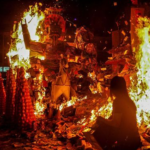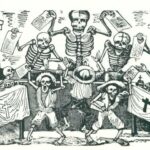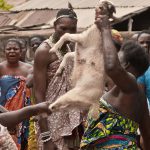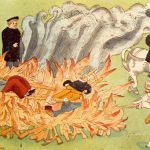Traditionally including a dance festival called Bon Odori, Obon (お盆) or just Bon (盆) is an annual three-day Buddhist festival held in honor of one’s ancestors celebrated in Japan for over 500 years. More recently, the holiday has become a time for family reunions, as people return to their hometowns and revisit the graves of the deceased.
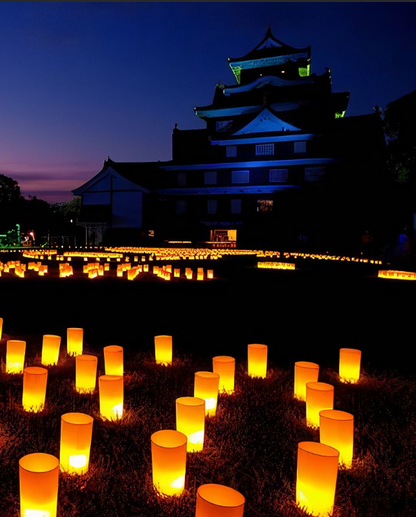
The official dates are August 13-15 though it will be celebrated between July 14-16 in some places. The Obon week in mid-August is one of Japan’s three major holiday seasons making it one of the busiest times of the year for traveling. Many Japanese people will leave their cities around August 10 and come back on August 17-18.
Origins
O-bon is believed to have originated in India, then spread to China and other parts of South Asia, eventually making its way to Japan. In it, a disciple of Buddha uses supernatural powers to contact the spirit of his deceased mother. Upon realizing his mother had descended to the ‘Realm of Hungry Ghosts’ (in Buddhism, a ‘hungry ghost’ is a supernatural being suffering from an insatiable hunger for a particular thing, often grotesque), the disciple became distressed and asked the Buddha how to free his mother’s spirit from her pain. Buddha instructed him to prepare offerings for the Buddhist monks who were returning from a summer retreat. Upon doing so, his mother’s spirit was freed.
Obon is the Japanese transliteration of the Sanskrit word ullambana, which means ‘to hang upside down’ and implies unbearable pain and suffering. For the Japanese, the festival is held to free ancestors’ spirits of their pain.
Obon traditions and celebrations
Before Obon begins, it is common to clean the homes and set out offerings to be prepared for when the spirits arrive.
The first day of Obon is for guiding the spirits home. People take the chochin lanterns to the graves of their families and call their ancestors’ spirits back home in a ritual called mukae-bon. They also light paper lanterns and hang them in their homes and on doorways.
Some regions light a giant fire called a mukaebi which is meant to welcome the spirits and families may also light a small bonfire at their homes.
It’s also common to create an altar for ancestors where offerings and small memorial tablets are placed. There are also special requirements for the offerings at the Obon altar. The most distinctive offerings are cucumbers and eggplants made into the shapes of horses and cows respectively. They are known as spirit mounts for the ancestors.
The horse is fast, and the ox is slow. Therefore, when the first day of calling the spirits home comes, people offer cucumber horses, and when the last day of guiding the spirits back to their resting places comes, people offer eggplant cows. It expresses the people’s hope that their ancestors will come back quickly and go away slowly.
Fish and meat are avoided. Food should be prepared to be directly edible. For example, grapes need to be washed and put in a bowl, and apples or pears need to be peeled and placed on a table.
The second day, families may invite Buddhist monks to visit their homes or go to a temple or shrine to recite prayers.
The greatest spectacle of the three-day event is Bon Odori, a traditional folk dance performed during Obon to welcome the spirits of the dead. Each region of Japan has its own unique style of dance and music, often containing lyrics and messages representative of that culture and history of that region. For example, the Tanko Bushi (literally, ‘coal mining song’) of the Kyushu region consists of movements that resemble the work of coal miners, such as pushing carts or digging.
In the middle of a square is a platform on which, usually, someone leads a song and the participants dance around it to the beat of Japanese taiko drums. Participants traditionally wear yukatas, a kind of light cotton kimono. Everyone is free to join the dance.
Entire families also often spend this day together laughing and telling stories about the deceased. Meals served on this day are typically vegetarian.
The third last day of Obon is for guiding the spirits back to their resting places or back to the water, which is where spirits are traditionally believed to reside. During this day, many regions light another bonfire and hang more lanterns painted with the family crest to guide spirits back to their graves.
There is a big ceremony of sending off fires in the mountains of Kyoto. People use wood to form a large “大” character, and then set it on fire.
Some regions of the country celebrate a festival called Toro Nagashi on this day which involves releasing hundreds of floating lanterns onto rivers and lakes. These floating lanterns are meant to guide the spirits back to their world. Each toro nagashi contains a candle and is often placed in a waterway that will eventually lead to the ocean. The ritual is called okuri-bon. Again, the ritual varies slightly between different regions of Japan.
Ghosts
To see ghosts in Japan one must put one hundred rush-lights into a large lantern, and repeat one hundred lines of poetry, taking one light out at the end of each line; or go out into the dark with one light and blow it out. Ghosts are identified with witches. They come back especially on moonlit nights.
“On moonlight nights, when the coast-wind
whispers in the branches of the tree, O-Matsue
and Teoyo may sometimes be seen, with bamboo
racks in their hands, gathering together the
needles of the fire.”
Japan’s Obon Festival vs China’s Hungry Ghost Festival
Japan’s Obon is similar to China’s Ghost Festival (Zhongyuan Festival). They have similar origins and taboos and are both related to death and the deceased. However, the Japanese Obon Festival is influenced by Buddhism and focuses on ancestor-worshipping celebrations while the Chinese Ghost Festival is more influenced by Taoism and more focused on the worship of ghosts.
Famous Obon festivals
The most famous Obon festivals in Japan are :
- Awa Odori (Tokushima, Shikoku),
- Nagasaki Shoro Nagashi Festival (Nagasaki),
- Hokkai Bon Odori (Mikasa, Hokkaido).
- The Daimonji Festival in Kyoto is probably the most famous. A series of spectacular, 200m-long, character-shaped bonfires are built on mountainsides which are visible throughout the city. Each one is then individually set on fire.
Asakusa is a district in Tokyo and is famous for its spectacular Obon festival celebrations. The area around Sensoji Temple is decorated with lanterns, and people can be seen offering food to the spirits. - For those looking to experience an all-night dance party, the Gujo Odori Festival in Gujo, (Gifu prefecture) runs for 32 nights and is welcoming to all guests willing to participate. Dancers perform each night from 8 pm until 5 in the morning. Over 1.3 million tourists go there each year.
The Bon Odori dances are organized almost everywhere, especially in residential neighborhoods. Larger and more formals events are also staged:
- Awa-Odori from August 12 to 15 in Tokushima,
- Koenji Awa-Odori festival on a weekend at the end of August in Tokyo.
Some of the top foods to try at street food stalls during Obon include Takoyaki (breaded octopus topped with pancake sauce and dried seaweed), maki sushi (traditional sushi rolls where all the ingredients are wrapped together in seaweed), yakisoba (fried noodles), yakitori (chicken skewers), and okonomiyaki (Japanese savory pancakes).


